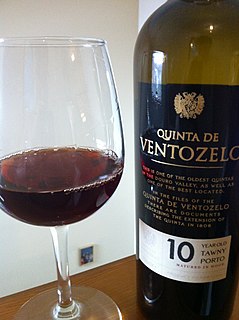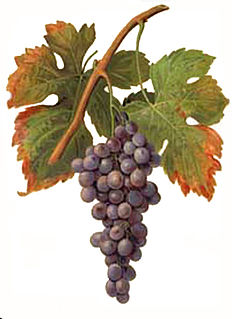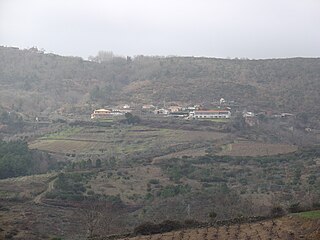Related Research Articles

Port wine is a Portuguese fortified wine produced in the Douro Valley of northern Portugal. It is typically a sweet red wine, often served as a dessert wine, although it also comes in dry, semi-dry, and white varieties.

Alicante Bouschet or Alicante Henri Bouschet is a wine grape variety that has been widely cultivated since 1866. It is a cross of Petit Bouschet and Grenache. Alicante is a teinturier, a grape with red flesh. It is one of the few teinturier grapes that belong to the Vitis vinifera species. Its deep colour makes it useful for blending with light red wine. It was planted heavily during Prohibition in California for export to the East Coast. Its thick skin made it resistant to rot during the transportation process. The intense red color was also helpful for stretching the wine during prohibition, as it could be diluted without detracting from the appearance. At the turn of the 21st century, Alicante Bouschet was the 12th most planted red wine grape in France with sizable plantings in the Languedoc, Provence and Cognac regions. In 1958, Alicante Bouschet covered 24,168 hectares ; by 2011, plantings represented less than 4,000 hectares. This scenario is largely reversed in other regions of Europe, and in southern Portugal, where its wines are highly prized and frequently outscore traditional autochthonous varieties.

Tempranillo is a black grape variety widely grown to make full-bodied red wines in its native Spain. Its name is the diminutive of the Spanish temprano ("early"), a reference to the fact that it ripens several weeks earlier than most Spanish red grapes. Tempranillo has been grown on the Iberian Peninsula since the time of Phoenician settlements. It is the main grape used in Rioja, and is often referred to as Spain's noble grape. The grape has been planted throughout the globe's wine regions.

Palomino Fino is a white grape widely grown in Spain and South Africa, and best known for its use in the manufacture of sherry. It is also grown in the Douro region of Portugal where it is used for table and fortified wines.

Touriga Nacional is a variety of red wine grape, considered by many to be Portugal's finest. Despite the low yields from its small grapes, it plays a big part in the blends used for ports, and is increasingly being used for table wine in the Douro and Dão. Touriga Nacional provides structure and body to wine, with high tannins and concentrated flavors of black fruit. Jancis Robinson has compared its relationship with Touriga Francesa to the partnership between Cabernet Sauvignon and Cabernet Franc, the former providing structure, the latter filling out the bouquet.

Portuguese wine is the result of traditions introduced to the region by ancient civilizations, such as the Phoenicians, Carthaginians, Greeks, and mostly the Romans. Portugal started to export its wines to Rome during the Roman Empire. Modern exports developed with trade to England after the Methuen Treaty in 1703. From this commerce a wide variety of wines started to be grown in Portugal. And, in 1758, one of the first wine-producing regions of the world, the Região Demarcada do Douro was created under the orientation of Marquis of Pombal, in the Douro Valley. Portugal has two wine-producing regions protected by UNESCO as World Heritage: the Douro Valley Wine Region and Pico Island Wine Region. Portugal has a big variety of local kinds, producing a very wide variety of different wines with distinctive personality.
Evora is a Portuguese wine region centered on the town of Évora in the Alentejo region. The region was initially a separate Indicação de Proveniencia Regulamentada (IPR) region, but in 2003, it became one of eight subregions of the Alentejo DOC, which has the higher Denominação de Origem Controlada (DOC) status. Its name may still be indicated together with that of Alentejo, as Alentejo-Évora.
Moura is a Portuguese wine region centered on the town of Moura in the Alentejo wine region. The region was initially a separate Indicação de Proveniencia Regulamentada (IPR) region, but in 2003, it became one of eight subregions of the Alentejo DOC, which has the higher Denominação de Origem Controlada (DOC) status. Its name may still be indicated together with that of Alentejo, as Alentejo-Moura.
Borba is a Portuguese wine region centered on the Borba Municipality in the Alentejo region. The region was initially an Indicação de Proveniencia Regulamentada (IPR) region, then elevated to Denominação de Origem Controlada (DOC) status. In 2003, it became one of eight subregions of the Alentejo DOC. Its name may still be indicated together with that of Alentejo, as Alentejo-Borba.
Portalegre is a Portuguese wine region centered on the Portalegre municipality in the Alentejo wine region. The region was initially an Indicação de Proveniencia Regulamentada (IPR) region, then elevated to Denominação de Origem Controlada (DOC) status. In 2003, it became one of eight subregions of the Alentejo DOC. Its name may still be indicated together with that of Alentejo, as Alentejo-Portalegre.
Redondo is a Portuguese wine region centered on the Redondo municipality in the Alentejo region. The region was initially an Indicação de Proveniencia Regulamentada (IPR) region, then elevated to Denominação de Origem Controlada (DOC) status. In 2003, it became one of eight subregions of the Alentejo DOC. Its name may still be indicated together with that of Alentejo, as Alentejo-Redondo.

Tinta Amarela or Trincadeira is a red wine grape that is commonly used in Port wine production. The grape is noted for its dark coloring. Its use in the Douro region has been increasing in recent years. The vine is susceptible to rot and performs better in dry, hot climates.

Cayetana blanca, also known as Cayetana or Jaén, is a white Spanish wine grape. It is grown mainly in the south of Spain, especially in Extremadura and in the Jerez region where it is distilled for use in brandy production.
Moreto is a red Portuguese wine grape variety that is planted primarily in the Alentejo. As a varietal, the grape makes neutral wines.
Marufo or Mourisco tinto is a red Portuguese wine grape that is planted primarily in the Douro DOC. It is a recommended grape in Port wine production.
Parraleta is a red Spanish wine grape variety which might also be known under various other names, such as Tinta Caiada in several Mediterranean countries. Parraleta is chosen as a prime name as it was used in Somontano, region located in the north-east Spain, which is its likely place of origin. DNA profiles of Tinta Caiada, and Carenisca, and Salceño Negro with that of Parraleta suggests that they are one and the same variety.

Vital is a white Portuguese wine grape variety that is grown primarily in Western Portugal. Sometimes known under the synonym Malvasia Corado, the variety tends to produce rather neutral flavor wine with low acidity unless the grape is grown in vineyards of high altitude.

Tinta Carvalha is a red Portuguese wine grape variety that is widely planted throughout Portugal, most notably in the Trás-os-Montes e Alto Douro Province, due to its easy maintenance and high yield potential. It is primarily a blending grape that on its own tends to produce light bodied, nondescript wines. It is an approved grape variety used in Port wine production as well as the non-fortified wines of the Chaves and Valpaços wine region.
Rufete is a red Spanish/Portuguese wine grape variety that is grown primarily used in port wine production in the Douro region of Portugal. It is also grown up along the Duero basin across the border in the Spanish province of Castile and León and can be found in the Dão DOC of Portugal where the variety is known as Tinta Pinheira.
References
- ↑ J. Robinson Jancis Robinson's Wine Course Third Edition pg 121 Abbeville Press 2003 ISBN 0-7892-0883-0